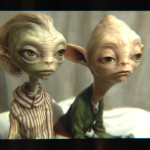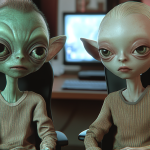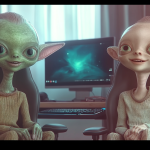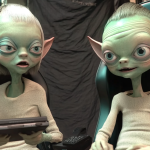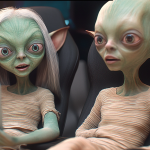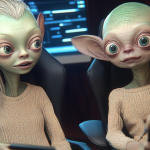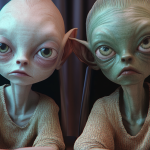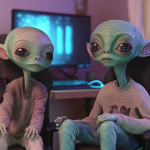Lyndsey – Blog Post 9 – Final Project Idea
My final project explores montage editing in a video essay format. I went with a 90s aesthetic camcorder of a forest, and stylistically made it like a personal diary entry. I was inspired by no specific video in particular, however, I was trying to mimic the nostalgic feeling of the late 2000s YouTube vlogs. They still exist today in crisp 1080p, but I found a new digital camera at Goodwill and immediately knew how to utilize it. I also felt that the theme of change worked well because, in a sense, graduating (at least at my age) feels like that final step into becoming an adult, and the video is a sort of diary on this trail that I spent a lot of time on in my youth. It showcases how change is inevitable, yet it is necessary to grow. That fear of growing up is still and probably will always be prevalent, and I believe this is a pivotal moment in my life. While I am accepting of change, by revisiting the trail conceptually and trying to fit the aesthetics of the 90s stylistically, I try to convey a bittersweet clinging to and release of my youth. The trail has changed in many ways, some good, some bad, but because of changes like these, I have also changed to become a better person. I focused on still and panning shots because my camera is only 480p, and the digital zoom was abysmal at best, and I felt that the restriction of only shooting close/far shots allowed me to be more creative in how I framed and told the story. Originally, I had planned on focusing mostly on wildlife, i.e, squirrels, birds, snakes, crawdads, but they were not interested in being a part of the project, so I had to focus more on the storytelling aspect to make it interesting. After reworking the script due to the lack of wildlife, it led me to feature my cats, which is the best part of the project!
View PostLyndsey – Blog Post 8 – Bandersnatch
Back in 1982, video artist Bill Viola imagined the future possibilities of digital video, coining the term “data space”. He saw it not just as storage, but as a potential new kind of place—a “conceptual geometry”—that could be explored by a “participant” rather than a passive viewer. Decades later, Netflix’s interactive film Black Mirror: Bandersnatch seems like a tangible, though complicated, step towards this vision. Bandersnatch throws us directly into interactive storytelling, letting us make choices for the main character, Stefan, and actively shaping the branching narrative. For many, myself included, it was an undeniably entertaining and immersive experience. Trying to uncover all the endings, seeing the direct consequences of our choices, and catching the clever links within the story was certainly engaging.
However, the sheer number of paths and potential outcomes could also feel overwhelming, sometimes making it difficult to track exactly how one decision led to a specific scene or ending. This highlights a core question about the interactive format. Interestingly, Viola anticipated structures beyond simple branching paths even back then, wondering about more fluid ways for a participant to navigate information and feeling that relying only on standard logic could be limiting. While Bandersnatch‘s A-or-B input mechanism might seem basic compared to Viola’s more complex theoretical models, the film compensates with remarkable narrative depth that itself explores non-linear ideas. Think of the scene where Colin discusses multiple realities during an LSD trip – if you choose for him to jump, seemingly to his death, he unsettlingly tells Stefan he’ll “see you next time.” Later, Colin can reappear via a delivered tape, blurring the lines of reality and consequence within the story itself. Even his casual acceptance and assistance if the player chooses for Stefan to kill him points to a narrative grappling with complex themes of free will, determinism, and the nature of reality, pushing beyond simple choices. This narrative complexity arguably engages with Viola’s interest in exploring different psychological states, even if the interface is simple. As Viola noted, the potential of technology requires introspection, stating, “…development of self must precede development of the technology or we will go nowhere…”.
So, where does this leave interactive storytelling? While Bandersnatch was a fascinating cinematic experiment, its complexity and the relative lack of similar follow-ups suggest the film format might have limitations for this kind of narrative. Currently, video games often seem better equipped to handle intricate branching stories. Games like Detroit: Become Human or The Quarry, while perhaps imperfect, adopt cinematic visuals but integrate choice-based mechanics within an infrastructure designed for interactivity, sometimes even providing clearer feedback or ways to track narrative paths. They offer a space where deep branching feels more natural to navigate. While film offers unparalleled live-action cinematic quality, the future of complex interactive narratives might lean more heavily towards gaming platforms that can better support the intricate structures required. Ultimately, pushing the boundaries in either medium requires creative thinking beyond established formulas. As Viola put it, “Artists have been to different parts of the brain, and know quite well that things don’t always work like they told you in school”.
View PostLyndsey – Vlog Post 7 – Favorite Place
Lyndsey – Blog Post 6 – Video Essay
Video essays offer a unique medium to explore complex ideas, blending a good academic feel with cinematic flair. Asa Park’s “How One Man Revolutionized Music,” which delves into Damon Albarn’s influential career, serves as an excellent case study in how spoken word interacts with imagery and sound to build a compelling narrative.
Asa Park’s essay masterfully intertwines various elements to support its central thesis about Albarn’s innovative spirit:
- Narrator and Voice-Over: The narrator’s spoken word guides the viewer through Albarn’s journey. It provides context, analysis, and transitions between different phases of his career, from Blur’s initial rise and the “battle of the bands” to the brilliance of Gorillaz songwriting and his consistent defiance of trends. The voice-over isn’t just informational; its tone and pacing contribute to the essay’s overall persuasive power.
- Text: On-screen text is used contextually, primarily to identify speakers in interview clips or introduce key concepts and dates. This textual language works in tandem with the voice-over and visuals, ensuring clarity without overwhelming the viewer. Animated text effects occasionally add another layer of visual engagement.
- Sound Design and Music Integration: The essay’s audio mixing is very detailed and well done. The narrator’s voice often coexists with on-screen audio (like crowd noise or interview snippets) and a fitting background music score. Additionally, the essay strategically uses Albarn’s own music to emphasize a specific point, stylistically, to further the essay’s argument. Sound effects, like shutter clicks, are also synchronized with visual cuts to enhance the essay’s rhythm and impact.
- Graphics and Visual Editing: The visuals are constantly changing and multi-layered. Asa Park captures a multitude of footage– old performances, interviews, music videos, archival shots, album art, news clippings – creating a variety and density of visuals. The editing is notably fast-paced, with most shots lasting only a few seconds, demanding the viewer’s attention. Longer segments are reserved for moments requiring specific emphasis. Editing techniques like highlighting subjects within a paused frame or juxtaposing different types of footage (e.g., a music video playing on an in-scene TV) add analytical depth.
While the technical execution is impressive, the production occasionally feels almost too polished. The seamless editing, crisp visuals, and perfectly staged narrator segments contribute to a highly professional feel, yet perhaps verges on feeling overly crafted, almost AI-like. The video is lacking a sense of raw authenticity or personal stylistic imperfection that might otherwise ground the piece.
Through this combination, the video essay doesn’t just tell us about Albarn’s impact; it shows and makes us feel it, using a blend of spoken word and modern audiovisual techniques. The integration of these components creates an immersive and convincing exploration of its subject.
Thinking about how I’d start writing my own video essays in the future, I suppose I’d first need a clear idea or argument I wanted to make. Then, drawing inspiration from some of Asa Park’s techniques, I’d think about how different elements could work together. I’d consider how voice-over could guide the viewer, how I might use text sparingly for key info, and how layering sound or using specific visual cuts could help emphasize certain points. I would definitely need to capture a library of footage intentionally rather than just a handful of clips that I used in my own recent video essay.
View PostLyndsey – Video Essay
Lyndsey – HTML Cinema
Lyndsey – AI Cinema
Lyndsey – Blog Post 5 – AI Project Shot List
Midjourney’s Mid Journey
Spent 3 days trying to find the exact look I want. It took quite some time to get it close to what I envisioned. Though I am a bit of a perfectionist, so I could’ve settled for earlier iterations. I ended up sort of doing that anyway.
Style References
Used a couple of these as a style reference. However, I noticed text prompting was easier than styling – Especially if I attached more than 1 style, I’d get some weird results and the aliens I had established would change entirely.
Top Alien Contenders
I really like the detail in the first picture, but had trouble translating that to a background setting that looked like it would be a YouTube video and not 60 Minutes. Also had trouble getting them to smile. So, I used the first picture as my main reference for the other aliens.
Current Winner
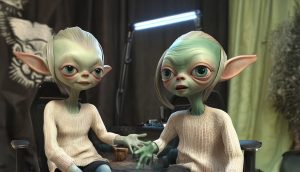
I picked this one as my main characters, since the aliens and the background seem like it would be in a YouTube video. For a while, I’d either get a really good background but the aliens look the exact same or had no special detail or character to them. I’d also get the opposite, where the aliens look very personable and different from each other, but the background was plain. Instead of a bedroom, it looks like they’re in a low budget set, which works for these characters.
I used Photoshop’s generative AI to expand the image a bit and change their hands. In the above 10 photos, this original one, straight from Midjourney, had some stretched, morphed hands.
I might change the image again, as these two aliens are not looking in the same direction and I’d need a bit more room on the right side to follow the rule of thirds, as the PIP reactionary video would probably sit on the right bottom corner.
View PostLyndsey – Blog Post 3 – Time Frames
Scott McCloud’s Understanding Comics provides a fascinating framework for understanding how time is constructed, not just in comics, but also in cinema. McCloud argues that while comics present a “time map” where past, present, and future are simultaneously visible, cinema primarily operates in a sequential “now.” However, skilled filmmakers can manipulate this “now” to create subjective experiences of time, mimicking some of the effects McCloud attributes to comics. A prime example of this can be found in “Fishes,” the intensely stressful Christmas episode of The Bear (season 2, episode 6).
McCloud emphasizes that panel size in comics influences the perceived duration of time. A wide panel suggests a longer timeframe, similar to a long cinema take. “Fishes” utilizes this principle during the climactic confrontation between Mikey and Uncle Lee at the dinner table. The extended, often unbroken takes of their escalating argument stand in stark contrast to the episode’s generally frenetic, quick-cut style, which mirrors the chaotic preparation of the seven fishes dinner earlier in the episode. These long takes, focusing on the raw, volatile emotions, stretch time, forcing the viewer to inhabit the agonizing discomfort of the moment. We’re trapped at that dining table with them and Carmy, experiencing the emotional weight of every insult and accusation thrown.
Furthermore, the concept of the “borderless panel” in McCloud’s work is that it evokes timelessness. This episode uses a different method to play around with our sense of time, it makes use of a “ticking clock”. The entire episode is built around a relentlessly advancing “clock”: Donna’s cooking. Her increasingly erratic behavior and the impending deadline of dinner serve as a constant, driving force. This is almost the opposite of a borderless panel, an underlying countdown that gives form to the entire episode. Creating a “time map,” similarly to flipping pages in a comic and feeling like you know the weight of the impending future and accumulated past. Every slammed pot, every frantic stir, every shouted instruction tightens the tension, creating a subjective experience of time accelerating towards an inevitable explosion. Donna is the timer.
Ultimately, “Fishes” demonstrates that while cinema lacks the spatial “time map” of comics, it possesses its own powerful tools for temporal manipulation. By employing long takes, a relentless “ticking clock,” and stylistic shifts, the episode creates a visceral, subjective experience of time, mirroring and expanding upon many of the techniques McCloud details in his exploration of comics. The episode does a great job in using cinematic language to not just show time, but to make the viewer feel it.
View PostLyndsey – Blog Post 4 – AI Project Brainstorming
Story Summary: I was thinking of taking inspiration from a YouTube creator, Neural Viz, who uses AI as a tool for creativity rather than an empty crutch. Their work uses AI to enhance their comedic meta-commentaries, and I want to aim for something similar – a spoof that uses AI to make a funny observation about online video culture itself. My idea is to create a spoof YouTube reaction video. Imagine a typical, slightly messy room, the kind you see in countless reaction videos online. In this room sit two aliens, Zorp and Gleep, who are set up to film a reaction video. The main screen behind them shows a small picture-in-picture (PIP) display. This PIP is where the “content” they are reacting to will play – and that content is intentionally terrible AI-generated video. Think abstract blobs of color that are supposed to be landscapes, nonsensical AI animations, or AI-generated human figures with constantly shifting, uncanny faces. The humor will come from the aliens’ over-the-top reactions to this objectively bad AI art. One alien, perhaps Zorp, could be completely enamored with the AI video, praising its “deep artistic expression” and “groundbreaking visuals,” while the other, Gleep, is utterly repulsed, making exaggerated gagging noises and complaining about the “atrocious” and “incomprehensible” imagery. The contrast between the truly awful AI video and the aliens’ strong, often opposing, reactions will be the core comedic element.
Visual Style: The visual style will deliberately mimic the low-budget, casual aesthetic of typical YouTube reaction videos. Think of channels like MoistCr1TiKaL, Cody Ko, or Danny Gonzalez, but also even more average, everyday YouTubers. The “set” would be a normal-looking room, maybe a living room or bedroom, slightly cluttered but not intentionally styled. Lighting would be practical and unflattering – overhead lights, desk lamps, nothing cinematic. Camera work would be simple, maybe slightly grainy, with basic framing, nothing too composed. Thumbnails would also follow the reaction video style – featuring the aliens with exaggerated facial expressions of shock, disgust, or amazement, maybe with some low-resolution text overlay. The key is to create a visual style that is instantly recognizable as a YouTube reaction video but with the added comedic element of alien characters and their over-the-top reactions to the intentionally jarring and low-quality AI-generated video playing in the PIP.
View PostLyndsey – Breaking Space
Lyndsey – Loops
Montage:
Snowy Valentines at the Waterfront during sunset.
Continuity:
Kitty eating dinner and licking her lips.
(Still working on infinite loop)
View PostLyndsey – In Class Assignments
Lyndsey – Making Space
Update:
I shot the video with my phone, freehand, but I didn’t like it so I will be rerecording with my friend’s nicer camera and monopod to hopefully get the feeling I pictured in my head. Below are my storyboards for the video:
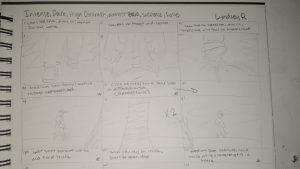


Lyndsey – Blog Post 2 – Brumes d’automne
Brumes d’automne (Autumn Mists), a 1928 silent film by Dimitri Kirsanoff, is a masterclass in early cinematic language. Even now, almost a century later, its experimental editing techniques remain captivating. Kirsanoff utilizes fast cuts, rhythmic montage, and close-ups to draw us into the internal world of a woman navigating a landscape of memory and emotion.
The film’s power lies in its ability to evoke a distinct mood. As the woman’s face, framed by dark eyes and porcelain skin, flickers across the screen, we are struck by a sense of unease. Her carefully sculpted eyebrows and pulled-back hair give her an unsettling, almost doll-like appearance. This, coupled with her restrained expressions, creates a feeling of something not quite human, like a porcelain doll animated by a lingering spirit.
Kirsanoff’s intention was to depict a state of mind through images of nature losing their “density and unity.” He achieves this through distorted perspectives, fragmented images, and scenes of nature in a state of flux, mirroring the woman’s inner turmoil. The fast-paced editing, innovative for its time, mirrors the fragmented nature of memory and thought. As new scenes appear, the accompanying music shifts, creating a symphony of visual and auditory cues that guide us through the woman’s emotional landscape.
However, the film’s impact may differ greatly depending on the viewer’s cultural context and experiences. While Kirsanoff’s editing was groundbreaking in 1928, modern audiences accustomed to rapid cuts and visual effects might find the film’s pace slow and its imagery dated. Furthermore, the woman’s doll-like appearance, coupled with the film’s melancholic tone, could easily be reinterpreted through a modern horror lens. Imagine the same footage with a sinister score – suddenly, the film transforms into something quite different. 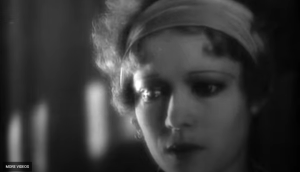
This raises an interesting question: Does the meaning of a film remain fixed over time, or can it evolve alongside cultural perceptions and technological advancements? Brumes d’automne serves as a reminder that art can be a fluid and dynamic entity, its interpretation shaped by the lens through which it is viewed. While Kirsanoff’s intentions are evident in his masterful use of montage and evocative imagery, the film’s impact ultimately rests in the hands and minds of its audience
Lyndsey – Blog Post 1 – Run Lola Run
Run Lola Run isn’t your typical heist film. It’s a vibrant, 90’s gamification experiment in cinema storytelling, where the protagonist, Lola, races against time to save her boyfriend, Manni. The film’s discontinuous style, blending film, animation, and polaroid photography, could easily become chaotic. Yet, the director, Tom Tykwer, masterfully maintains coherence and momentum, keeping us on the edge of our seats through three iterations of the same 20-minute sprint.
One key to this coherence is the repetition of Lola’s quest and driving motivation to obtain $100,000. While the broader narrative shifts with each “run,” familiar elements ground us. We see Lola repeatedly leaving her apartment (in animation) and navigating the same Berlin streets (in film), encountering recurring characters that aren’t essential to the main plot, like the older woman with her baby and the nuns getting in her way. This repetition creates a rhythmic structure, allowing the audience to anticipate certain events while remaining alert for deviations.
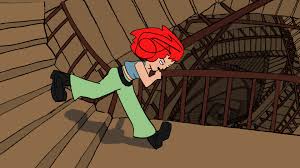
But repetition doesn’t mean stagnation. Tykwer cleverly uses these recurring encounters to explore the butterfly effect. Each time Lola interacts with someone, even in passing, their lives, and ultimately hers, are subtly altered. A bumped shoulder here, a different reaction there, can lead to vastly different outcomes, visually conveyed through rapid-fire flash-forwards of their potential futures as Polaroid still photography.
Driving this narrative is Lola’s fierce determination to save Manni, a desire born from love and a questioning of her own devotion. This propulsive energy fuels the frantic editing, mirroring her racing heartbeat and the ticking clock. The urgency is palpable, heightened by the recurring motif of clocks and timepieces.

Tykwer manipulates time not just through editing, but also through pacing. The first run feels incredibly compressed, bombarding us with information and new faces. This mirrors Lola’s initial panic and the audience’s own disorientation. As the film progresses, time seems to stretch and contract. The final run, with Lola’s casino gamble, feels almost suspended in time, building suspense as the roulette wheel spins.
Furthermore, the intimate scenes between Lola and Manni, bathed in red light, provide a crucial break from the frenetic pace. These moments, detached from the external chaos, offer a glimpse into their emotional connection, reminding us of the stakes involved.
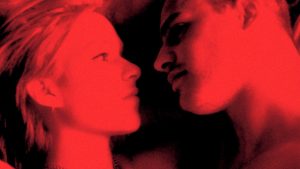
Run Lola Run is a testament to the power of cinematic storytelling. Through innovative editing, visual motifs, and a compelling narrative, Tykwer crafts a film that is both thrilling and thought-provoking, leaving us to ponder the nature of time, chance, and the choices that shape our lives.
View PostLyndsey – One Day in 30 Seconds
Visited Leavenworth for the first time this weekend. I had so many other shots I did not include because I wanted the 30-second challenge. I have a personal copy for myself that’s around 3 minutes! Did I add royalty-free music because it fits the vibe perfectly? Yes. Remove points if you must!
View Post





